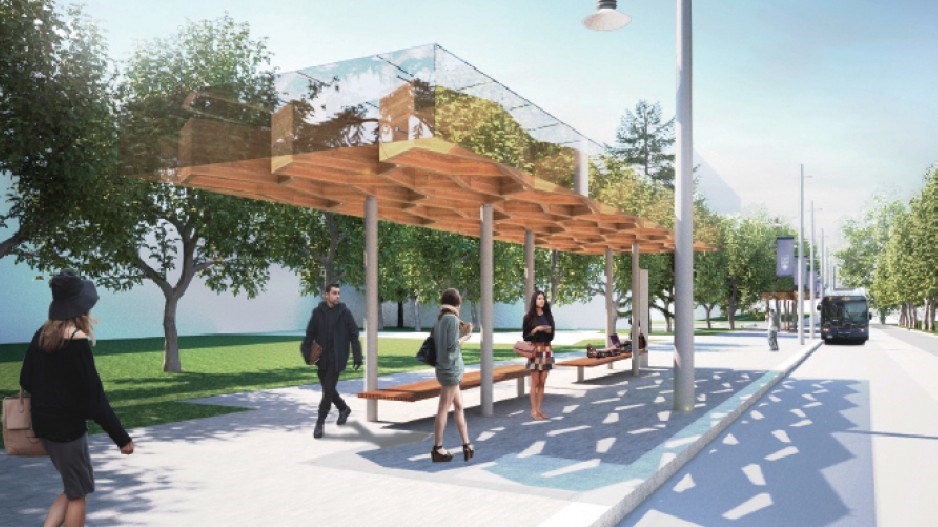School bus run
One of the first elements in a makeover of University Boulevard at UBC’s Point Grey campus opened last week, just in time for the new academic year.
The makeover has been years in the making – and has itself undergone a makeover or two.
UBC’s original 2003 plan envisioned an underground transit hub beneath the university’s student union building, among other improvements. An international design competition in 2005 received more than 50 submissions for a $100 million proposal to “redesign University Boulevard and [to] create a signature gateway and new social heart for UBC.”
But competition winner Moore Ruble Yudell Architects and Planners of Santa Monica, California (in partnership with Hughes Condon Marler Architects of Vancouver) ultimately withdrew from the project, and then in 2009 TransLink scaled back its financial contribution.
“[UBC’s] board of governors asked us to go right back to the drawing board,” said Joe Stott, director of planning with Campus and Community Planning at UBC.
Consultations led to a more traditional makeover of University Boulevard. It included an above-ground transit terminus adjacent to a new student union building with MacInnes field where the aquatic centre now stands (the aquatic centre will be moved to what’s now MacInnes field).
“It’ll be a nice front yard to the student union building,” Stott said of the relocated playing field.
What opened last week was the new trolley bus loop, which will eventually be joined by the diesel bus loop currently located on the opposite side of MacInnes field. The new aquatic centre should be completed by 2015, though, as Stott observed: “Anything beyond two years is really hard to predict.”
Meanwhile, on False Creek...
While attention last week focused on the opening of London Drugs in the Village on False Creek, the return of students also draws attention to the ongoing absence of the planned elementary school from the village.
The city’s vision for the development includes plans for a 40,000-square-foot school on the west side of the site, but Ernest Fanthorpe, manager of facility development with the Vancouver School Board (VSB), said negotiations remain in a preliminary phase.
VSB representatives are discussing development prospects with the province, the city and the Conseil scolaire francophone de la Colombie-Britannique, which oversees 36 francophone schools in the province and is scouting southeast False Creek for a new location.
Fanthorpe expects the francophone school will be smaller than the VSB school, but accommodating both institutions adjacent to the village will be a balancing act.
There’s plenty of time for planning, however, at least from the VSB’s perspective, Fanthorpe said. While the village is increasingly inhabited, with rental units fully occupied and 545 of the village’s 737 market units sold (and construction of adjacent towers on the go), there’s still little need for a school.
“There isn’t a population for it,” Fanthorpe said.
Housing unaffordability
The latest housing affordability survey from RBC Economics underscores the dynamic playing out in the Metro Vancouver real estate market.
Released last week, the quarterly RBC survey reports that home affordability in Metro Vancouver approached all-time lows in the second quarter of this year. Detached homes – bungalows and standard two-storey homes – require more than 90% of household income, while condos require 45.2% of household income. Affordability for all categories of housing declined from 2012’s first quarter.
As a result, the report’s authors say, “extremely poor affordability appears to have caught up with the Vancouver area market.” Benchmark sale prices for MLS-listed homes have dropped 1.5% through the summer, ending July at $616,000. August sales statistics (which should be available by the time this column hits the streets) will likely confirm the trend.
But as Central 1 Credit Union recently reported, there’s no need for widespread panic. While median prices will decline by as much as 5% this year, this will largely reflect the kinds of properties that are selling as well as year-over-year shifts in activity.
Downward pressure on prices will likely draw in buyers that could help keep prices steady through 2013 and 2014. •




